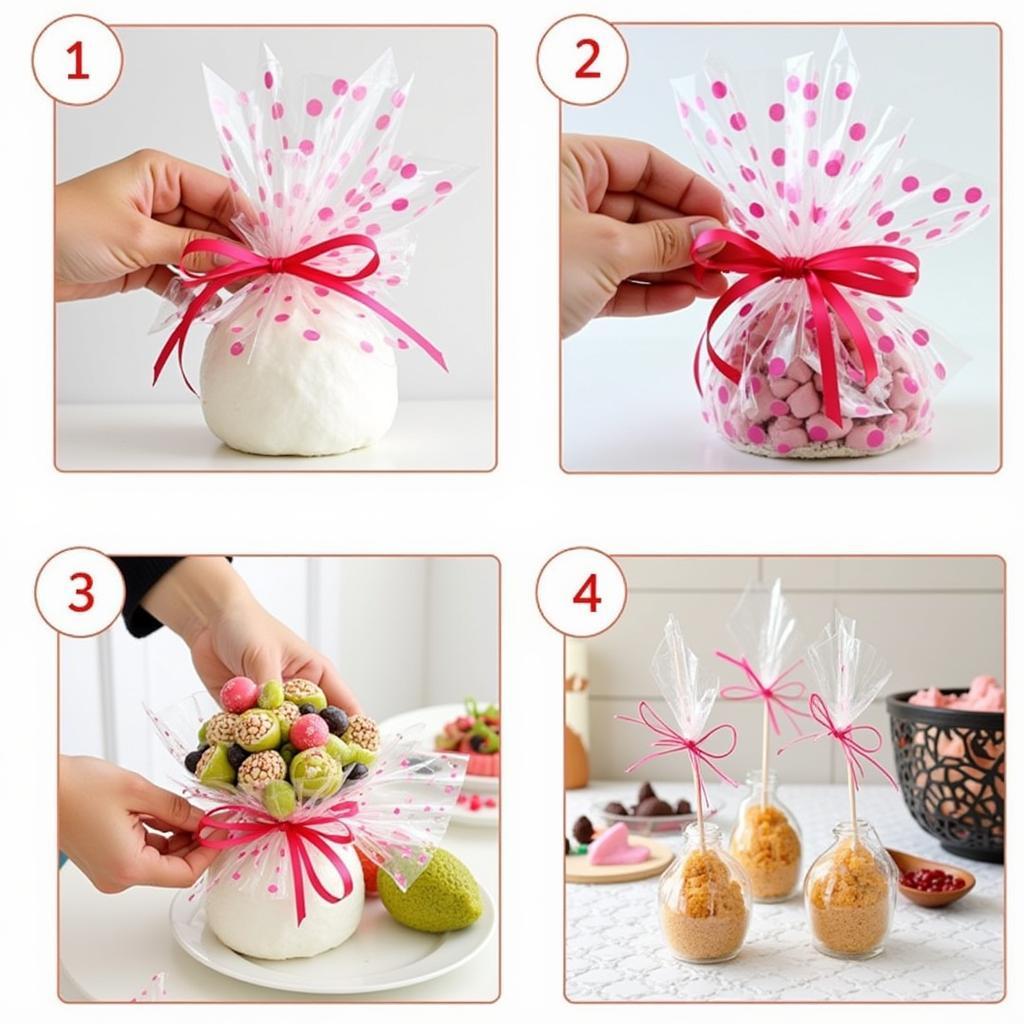Cellophane Food packaging has become a ubiquitous part of our modern lives. From preserving the freshness of our groceries to showcasing delectable treats, cellophane plays a crucial role. But beyond its practical applications, what do we really know about this versatile material? This article delves into the world of cellophane food, exploring its history, uses, benefits, and addressing common concerns.
A Brief History of Cellophane Food Packaging
In the early 1900s, Swiss chemist Jacques Brandenberger invented cellophane while seeking a stain-resistant tablecloth material. He noticed a transparent film forming on discarded fabric and realized its potential. Although initially intended for textiles, cellophane quickly found its niche in the food industry, revolutionizing packaging and preservation. It wasn’t long before cellophane food packaging became a staple, offering a clear, protective barrier against moisture, dust, and contaminants. Visit our page on cellophane food bags to explore different options.
The Versatility of Cellophane Food
From simple sandwich wraps to elaborate gift baskets, cellophane’s versatility is truly remarkable. Its transparency allows consumers to see the contents without compromising hygiene, making it ideal for displaying visually appealing treats like gift bag food. Cellophane is also an excellent choice for packaging baked goods, preventing them from drying out while showcasing their tempting textures. Its ability to be heat-sealed makes it a reliable choice for storing various food products, extending their shelf life and ensuring optimal freshness. For attractive food gift options, check our cellophane food gift bags.
Is Cellophane Food Safe? Addressing Common Concerns
Some consumers have expressed concerns about the safety of cellophane food packaging. Let’s address these head-on.
Is Cellophane Biodegradable?
While traditional cellophane derived from cellulose is biodegradable, many modern versions utilize synthetic polymers, reducing their biodegradability. However, advancements in biodegradable cellophane alternatives are continuously being made.
What are the Health Risks of Using Cellophane?
Cellophane itself poses minimal health risks. However, some plasticizers used in certain types of cellophane have raised concerns. Choosing cellophane labeled as “food-grade” ensures it meets safety standards for food contact.
Tips for Using Cellophane with Food
- Proper Sealing: Ensure a tight seal to prevent air and moisture from entering.
- Storage: Store cellophane-wrapped food in a cool, dry place away from direct sunlight.
- Handling: Always wash your hands before handling cellophane-wrapped food.
“When choosing cellophane for food packaging, prioritize clarity and food-grade certification,” advises renowned food safety expert, Dr. Amelia Hernandez. “This ensures both visual appeal and consumer safety.”
Creative Uses for Cellophane Food Wrap
 Creative Cellophane Food Wrap Uses
Creative Cellophane Food Wrap Uses
Beyond its functional uses, cellophane can also add a touch of creativity to food presentation. Use cellophane wrap food to create stunning gift baskets or individual dessert portions, adding a touch of elegance to any occasion. You can even use colorful cellophane to craft decorative bows and ribbons. For a unique twist, consider exploring cello food options.
“Cellophane’s versatility extends beyond mere functionality,” says culinary stylist, David Lee. “Its transparency and malleability make it a perfect canvas for adding a creative touch to food presentation.”
Conclusion: The Enduring Appeal of Cellophane Food
From preserving freshness to enhancing visual appeal, cellophane food packaging remains a staple in the culinary world. By understanding its properties and addressing safety concerns, we can continue to enjoy the benefits of this versatile material. Choosing the right type of cellophane ensures both the safety and aesthetic appeal of your food.
FAQ
- What is cellophane made of?
- Is cellophane recyclable?
- Can I microwave food wrapped in cellophane?
- What are the alternatives to cellophane food wrap?
- How do I store cellophane?
- Is cellophane food wrap waterproof?
- How can I dispose of cellophane responsibly?
Common Cellophane Food Scenarios
- Bakery Display: Cellophane keeps pastries fresh and appealing on display.
- Gift Giving: Cellophane adds a touch of elegance to food gift baskets.
- Home Storage: Cellophane wraps protect leftovers from spoiling in the refrigerator.
Further Exploration
Explore more food packaging options on our website. Learn about different types of food bags and wrapping solutions.
Need assistance? Contact us at 02437655121 or [email protected]. Visit us at 3PGH+8R9, ĐT70A, thôn Trung, Bắc Từ Liêm, Hà Nội, Việt Nam. We offer 24/7 customer support.